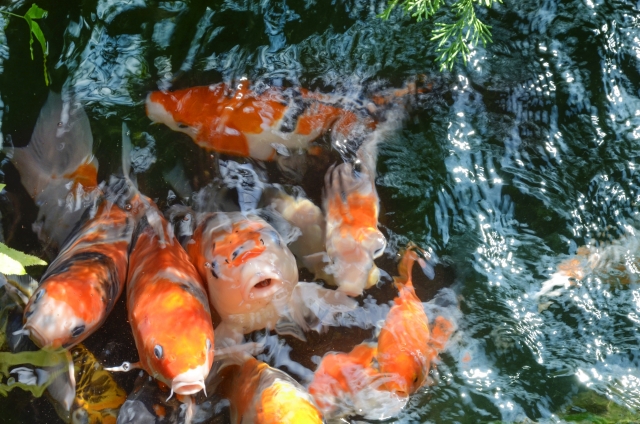Visited Lafcadio Hearn Memorial Museum and the old residence in Matsue, Shimane. Lafcadio Hearn (1850-1904) is an important figure who cultivated the genre of Japanese folklore. Hearn was an Greek born English man who later naturalized Japanese as Koizumi Yagumo. One of his works “KWAIDAN”, Japanese primitive ghost tales and the spiritual belief is worldly famous, but here I want to analyze into his spirit that supported the distinguished achievement.
島根の松江にある小泉八雲記念館と旧居を訪れた。小泉八雲ことラフカディオ・ハーン(1850-1904) は、日本の民俗学というまだ当時は確立されていなかった学問分野を切り開き、大変意義深い仕事を残した人である。ギリシア生まれのイギリス人であったハーンは、後に日本に帰化して小泉八雲となった。古くから伝わる日本の幽霊や精霊信仰のことを記した著書「怪談」は世界的に有名だが、ここでは、人とは一線を画したその業績を成し遂げた精神を支えたものを、分析して行ってみたい。

Lafcadio Hearn was left alone from parents when little and raised up by aunt, and he experienced another tragedy of losing his left eye when playing. The catastrophe remained as stagnant complex that never ceased. On the contrary, five senses that captured beauty in smallest thing were polished and refined. And he nurtured special empathy toward spirits in delicate and feeble matters.
ラフカディオ・ハーンは幼い頃に両親と離れ離れになり、伯母に引き取られて過ごすも、少年の日に遊戯中の事故で左目を失うという悲劇を経験している。このことは終生続く劣等感となるが、その代わりにあらゆる感覚や美意識が研ぎ澄まされて、繊細なものに宿る細やかな機微を解し共感する心を育んで行ったと考えられている。
As a student, he was studying in Catholic disciplined school but disappointed in the teachers and the priests that were filled with hypocrisy. The days of agonies and torments transformed into the backbone that yielded the great accomplishment.
また、カトリック系の学校に通うが、そこでの偽善的な教師や神父たちのあり方に深く失望して、キリスト教に救いを見出せないでいた。この若き日の苦悩が、後のハーンの仕事を支える背骨となって行く。

Hearn was poor at math, but he was blessed with a remarkable writing skill and made a living as a journalist. The reason why he made a voyage to Japan was that he was dispatched as a foreign correspondent. He didn’t show any interest to Tokyo, Osaka, nor Yokohama that were thriving and busy with good economy. But he had special attachment to Matsue, Shimane and the country lifestyle. He found and depicted small, and queer, and mysterious things that were from the ancient times. He showed sympathy toward something trivial and trifling.
ハーンは数学は苦手だったが、その代わりに稀有な筆力に恵まれており、新聞記者という文筆業で生計を立てる。日本に渡航したのも、海外特派員として派遣されたからである。ハーンは当時活況に湧いていた東京や大阪や横浜などの大都市ではなく、島根の松江を愛し、その古くからあった日本の暮らしの中に生きていた、儚くささやかな機微に新鮮な驚きをもって共感し、拾い上げて書き記して行った。
His best friends were butterflies, insects, frogs, the sunset, and bamboo shoots. Hearn cherished the evanescent beauty, his son Koizumi Kazuo wrote. He saw fragrant and evaporating sentiments like perfume and treasured them more than anything.
ハーンの親友は蝶や虫やカエルや夕焼けや筍などの「かそけきもの」であったと、その息子、小泉一雄が書いている。ふわりと芳香を放ち、すぐに立ち消えて行く情緒を、美しき佳きものとして何よりも深く味わった。

Bon Odori of summer dance festival, Fox Shrines, croaking frog voice in the Japanese garden, and folktales of Sanin area, he wrote about the ancient customs and the Japanese mindset that no Japanese paid special attention since they were becoming to be believed as outdated. He wrote with awe and enchanting freshness with beautiful nostalgia and he let the world know of the beauty. He became a frontier of Japanese folklore, and we can learn something consequential from his attitude as a Japanologist.
盆踊りや、お稲荷さんや、日本庭園で鳴くカエルの声や、山陰地方に伝わる民間伝承など、日本に古くからありながらも当たり前のものとして誰も気に留めず、むしろ時代遅れになって来ていた風習やその心を、繊細な視点で情緒豊かに描写して、広く世界に知らしめ、日本における民俗学の先駆けとなる仕事をしてゆく。この日本研究者としての姿勢から、私たちが学ぶものは多い。

In the Memorial Museum, I bought two books “GLIMPSES OF UNFAMILIAR JAPAN” and “KWAIDAN” and reading the former now with so much delight. Hearn’s work is overflowing with sincerity that captures something with sheer amazement and embraces it with dearness. In the exotic country of Japan, he observed small things with affection and wrote about them with special bonding while echoing one another. By doing so, he cultivated the new academic field.
記念館にて”GLIMPSES OF UNFAMILIAR JAPAN” (邦題「知られぬ日本の面影」)と”KWAIDAN” (邦題「怪談」)の原書を2冊買い、 今は前者を楽しく読み進めているところだ。ハーンの仕事は「驚きをもって感じ入り、それをしみじみと慈しむ心」で溢れている。日本という異国で、小さなもの達を深い情愛を持って観察し、共鳴共震しつつ記述して、それを一つの体系にまで昇華させて行った。
In the old residence of Hearn’s, the small Japanese garden that he loved was remained untouched and a frog was croaking. I pondered over Lafcadio Hearn who loved this sound and felt as if I encountered with him, caught a glimpse of his face.
小泉八雲旧居では、ハーンが愛した小さな日本庭園が当時のままに残されていて、カエルが池で鳴いていた。この鳴き声を愛したハーンのことをしばし思い耽り、時空を超えてハーンの面影と出会ったような気持ちになった。

Natsume Soseki who contributed to establish Japanese modern literature respected and admired Hearn as his master. The novel of Soseki “Sanshirou” can be read as based upon his own experience in university days, and there is a description of Hearn aka Koizumi Yagumo.
日本の近代文学において大きな貢献をした夏目漱石は、ハーンのことを心の師匠として仰いでいた。漱石自身の大学時代を下敷きにしているとも読める小説「三四郎」の中でも、小泉八雲ことハーンに関する記述がある。
Quote-“Late professor Koizumi Yagumo loathed going into the teacher’s room and he kept walking around the pond over and over after finishing a lecture. He said as if he learned from professor Koizumi. Sanshiro asked why didn’t he go into the teacher’s room and was answered “For sure, you can notice by attending their lectures. No one can speak English.” Sanshiro was marveled as the guy slapped the teachers nonchalantly.”-unquote. (translated the original by myself)
引用−「死んだ小泉八雲先生は教員控室へ這入るのが嫌いで講義が済むといつでもこの周囲(注:三四郎池のこと)をぐるぐる廻ってあるいたんだと、あたかも小泉先生に教わった様な事を云った。何故控室へ這入らなかったのだろうかと三四郎が尋ねたら、『そりゃ当たり前ださ。第一彼等の講義を聞いても解るじゃないか。話せる(注:英語を)ものは一人もいやしない』と手痛い事を平気で云ったには三四郎も驚いた。」−とある。

Soseki experienced teaching English in Kumamoto same as Hearn, and taught in Imperial University of Tokyo as a successor of Hearn, and they are resting in peace together in Zoushigaya Grave Yard. Encounter with a master whom you respect and admire from the bottom of your heart is one of the most delightful experiences in life.
漱石はハーンと同じく熊本で英語教師をし、東京帝国大学ではハーンの後任として教え、同じ雑司ヶ谷墓地で今も一緒に眠っている。心から尊敬できる師匠との出会いは、人生において最も幸福なる体験の一つだ。
Love and Peace to the world…
世界に愛と平和があります様に。
参考文献:”GLIMPSES OF UNFAMILIAR JAPAN” Lafcadio Hearn, TUTTLE, 2009
「三四郎」夏目漱石、新潮文庫、昭和二十三年






















